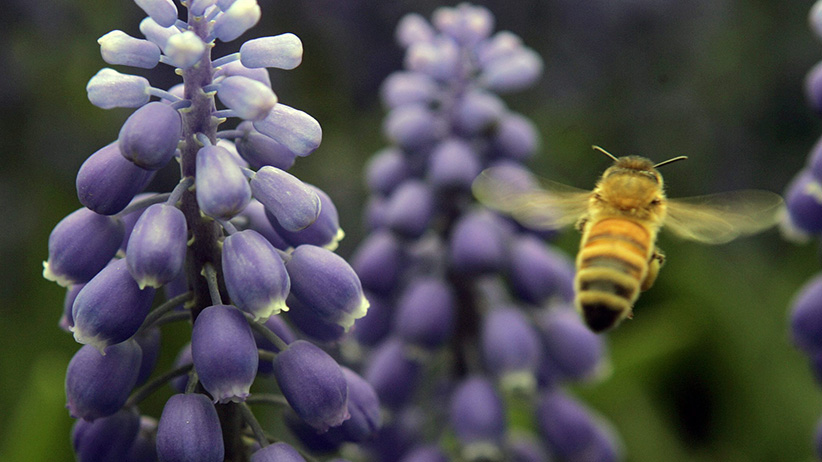Editorial: Save the bees, but not with an all-out pesticide ban
The death of the honeybees is a serious matter, but a sweeping pesticide ban may actually make things worse
A carniolan honey bee works the hyacinth in Washington Park in Albany, N.Y., Wednesday, May 7, 2008. City dwellers across the country are rapidly discovering the appeal of urban beekeeping. Large cities like Chicago, Seattle, Boston, Dallas and San Francisco are even promoting beekeeping for pollination health, to keep city vegetation green and lush. In New York City, a growing population of beekeepers are raising the insects in community gardens and on building roofs, even though it’s technically illegal to keep bees in the Big Apple. (Mike Groll/AP)
Share

There’s been a lot of buzz about bees lately—a buzz of concern. Fears that a frequently used insecticide is laying waste to bee colonies across North America have led to calls from environmental groups for immediate and drastic action by Ottawa. As satisfying as it may be to demand a sweeping ban, this is not an issue to be decided by emotion or mindless sloganeering. Sorting out the interrelated complexities of bee health and the agricultural industry requires time, evidence and proper scientific technique to ensure no one gets stung.
The significance of a healthy honeybee population is beyond dispute. Many of Canada’s most important agricultural crops, from fruits and vegetables to canola, require bees for pollination. They play an equally important role in the natural environment, not to mention all that honey. Any threat to the health of bees deserves to be taken seriously.
Recently, winter deaths in bee colonies across North America have been higher than usual. In 2012 and 2013, there was an unusual number of summertime bee deaths in Ontario and Quebec. The popular suspect in both events is a new class of insecticides called neonicotinoids. The case against neonics was bolstered this week by a heavily publicized report from the Switzerland-based International Union for Conservation of Nature (IUCN) on the insecticide’s alleged impact on bees and other animals. The Sierra Club of Canada, the David Suzuki Foundation, the Wilderness Committee, Friends of the Earth and many more environmental organizations have called for an immediate ban on neonics, as is currently the case in Europe.
Before condemning neonics as stone-cold bee killers, however, some background is necessary. Insecticides will always be hazardous to bees—they’re insects, after all. It is the task of the agriculture industry to fight the various grubs and beetles that threaten crops in a way that doesn’t unnecessarily damage beneficial insects, such as bees and butterflies. To this end, neonics represent a major leap forward, because they’re applied directly to seeds as a coating before planting. This eliminates indiscriminate field spraying and keeps the insecticide as far away as possible from hard-working bees. Plus, neonics have replaced many older and more lethal organophosphorus insecticides. “The use of seed treatment to apply insecticides to crops is an exceptional advance,” says Cynthia Scott-Dupree of the University of Guelph’s school of environmental sciences. “It often requires one-fortieth the amount compared to spray treatment, is very targeted and far less hazardous to the handlers.”
More Maclean’s editorials:
Is there hope for a car-bike détente?
Knock, knock. Who’s there? Not the enumerators.
It’s time for Canada to increase highway speed limits
While environmental groups and the IUCN report point the finger at neonics as the solitary villain in the recent rash of bee deaths, real-world evidence is not nearly so clear-cut. The U.S. Department of Agriculture recently looked at bee health and concluded “the single most detrimental” threat to be the deadly varroa mite, not pesticides. When Scott-Dupree and Christopher Cutler of Dalhousie University reviewed the most serious cases of mass bee deaths caused by pesticides between 2007 and 2012, they found neonics were implicated in just four of 20 incidents. And, in a large-scale field experiment, the researchers carefully compared bees foraging on neonic-treated crops with those in control fields. “We didn’t find any impact on bee deaths, honey production or any other determinant of bee health from neonic exposure,” Scott-Dupree reports.
Further complicating the case against neonics is Western Canada’s massive 21-million-acre neonic-protected canola crop. The Prairie honeybee population is growing at a very healthy rate without any of the problems experienced in central Canada.
As for the specific incidents in 2012 and 2013, last year the federal government’s Pest Management Regulatory Agency (PMRA) concluded that hot, dry and windy conditions during planting season in Ontario and Quebec likely caused neonic dust to waft onto bees foraging nearby. To solve this problem, a special dust-reducing lubricant is now mandated during planting. Given the many advantages neonics offer, such measures deserve a chance to prove their worth. The PMRA plans a comprehensive review of neonics, bee health and various remediation procedures in co-operation with the U.S. government by 2015. While impatient environmental groups dismiss this as a delaying tactic, it’s how proper science is carried out: carefully and rigorously.
Finally, it is important to keep in mind the spectre of unintended consequences. Modern improvements in yield, and reductions in food prices, which benefit all consumers, are the product of scientific farming methods, of which effective pest management is a major component. Denied access to neonics, farmers will inevitably revert to spraying their fields—either from the ground or by plane—with older and more dangerous insecticides. Such a situation could put the health of bees and humans at much greater risk.